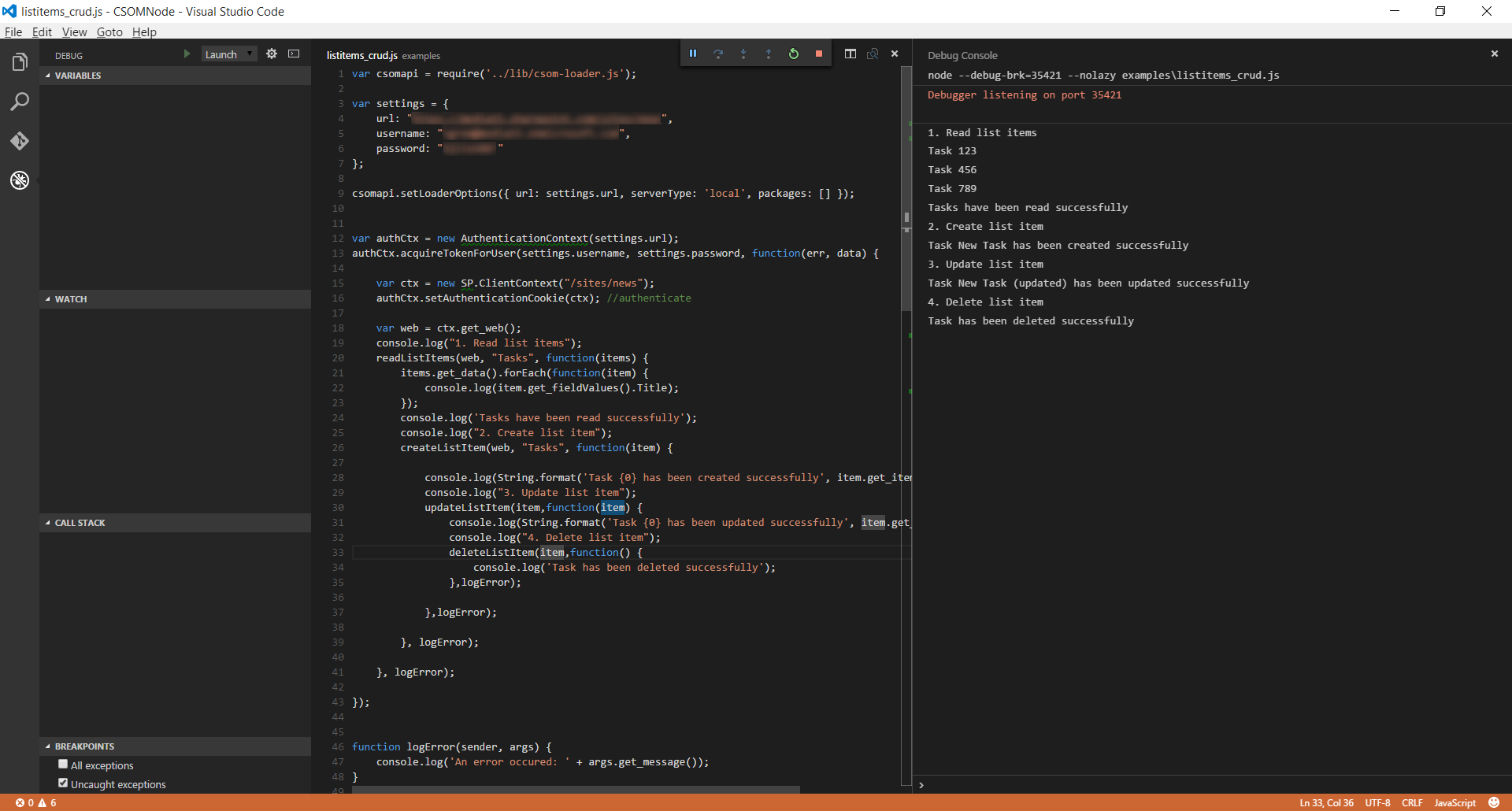The library provides a SharePoint Client Object Model (CSOM) API for Node.js applications.
The current version supports SharePoint Online CSOM library (v 16) The remote authentication is performed via Claims-Based Authentication.
$ npm install csom-node
-
CSOM API - currently only Core object library for JavaScript is supported plus some additional packages listed below
-
AuthenticationContext- represents an object that provides credentials to access SharePoint Online resources.
The list of supported CSOM API packages
-
policy
Authentication
Authenticate with user credentials
var csomapi = require('csom-node');
var settings = {
url: "https://contoso.sharepoint.com/",
username: "[email protected]",
password: "password"
};
csomapi.setLoaderOptions({url: settings.url}); //set CSOM library settings
var authCtx = new AuthenticationContext(settings.url);
authCtx.acquireTokenForUser(settings.username, settings.password, function (err, data) {
var ctx = new SP.ClientContext("/"); //set root web
authCtx.setAuthenticationCookie(ctx); //authenticate
//retrieve SP.Web client object
var web = ctx.get_web();
ctx.load(web);
ctx.executeQueryAsync(function () {
console.log(web.get_title());
},
function (sender, args) {
console.log('An error occured: ' + args.get_message());
});
});
Authenticate with app principal credentials (client id & client secret)
var csomapi = require("csom-node");
var settings = {
url: "https://contoso.sharepoint.com/",
clientId: "YOUR-GUID-GOES-HERE",
clientSecret: "YOUR-CLIENT-SECRET-GOES-HERE"
};
csomapi.setLoaderOptions({url: settings.url}); //set CSOM library settings
var authCtx = new AuthenticationContext(settings.url);
authCtx.acquireTokenForApp(settings.clientId, settings.clientSecret, function (err, data) {
var ctx = new SP.ClientContext("/"); //set root web
authCtx.setAuthenticationCookie(ctx); //authenticate
//retrieve SP.Web client object
var web = ctx.get_web();
ctx.load(web);
ctx.executeQueryAsync(function () {
console.log(web.get_title());
},
function (sender, args) {
console.log('An error occured: ' + args.get_message());
});
});
Working with List Items
The following example demonstrates how to perform CRUD operations against list items:
var csomapi = require('csom-node');
var settings = {
url: "https://contoso.sharepoint.com/",
username: "[email protected]",
password: "password"
};
csomapi.setLoaderOptions({ url: settings.url, serverType: 'local', packages: [] });
var authCtx = new AuthenticationContext(settings.url);
authCtx.acquireTokenForUser(settings.username, settings.password, function(err, data) {
var ctx = new SP.ClientContext("/");
authCtx.setAuthenticationCookie(ctx); //authenticate
var web = ctx.get_web();
console.log("1. Read list items");
readListItems(web, "Tasks", function(items) {
items.get_data().forEach(function(item) {
console.log(item.get_fieldValues().Title);
});
console.log('Tasks have been read successfully');
console.log("2. Create list item");
createListItem(web, "Tasks", function(item) {
console.log(String.format('Task {0} has been created successfully', item.get_item('Title')));
console.log("3. Update list item");
updateListItem(item,function(item) {
console.log(String.format('Task {0} has been updated successfully', item.get_item('Title')));
console.log("4. Delete list item");
deleteListItem(item,function() {
console.log('Task has been deleted successfully');
},logError);
},logError);
}, logError);
}, logError);
});
function logError(sender, args) {
console.log('An error occured: ' + args.get_message());
}
function readListItems(web, listTitle, success, error) {
var ctx = web.get_context();
var list = web.get_lists().getByTitle(listTitle);
var items = list.getItems(SP.CamlQuery.createAllItemsQuery());
ctx.load(items);
ctx.executeQueryAsync(function() {
success(items);
},
error);
}
function createListItem(web, listTitle,success,error) {
var ctx = web.get_context();
var list = web.get_lists().getByTitle(listTitle);
var creationInfo = new SP.ListItemCreationInformation();
var listItem = list.addItem(creationInfo);
listItem.set_item('Title', 'New Task');
listItem.update();
ctx.load(listItem);
ctx.executeQueryAsync(function () {
success(listItem);
},
error);
}
function updateListItem(listItem,success,error) {
var ctx = listItem.get_context();
listItem.set_item('Title', 'New Task (updated)');
listItem.update();
ctx.load(listItem);
ctx.executeQueryAsync(function () {
success(listItem);
},
error);
}
function deleteListItem(listItem, success, error) {
var ctx = listItem.get_context();
listItem.deleteObject();
ctx.executeQueryAsync(function () {
success();
},
error);
}
Visual Studio Code screenshot

